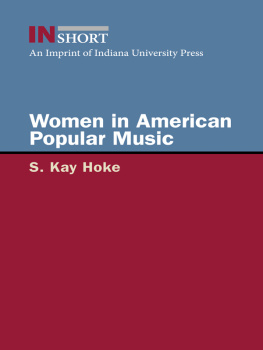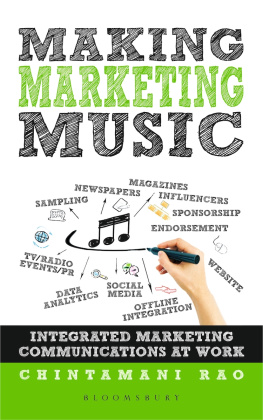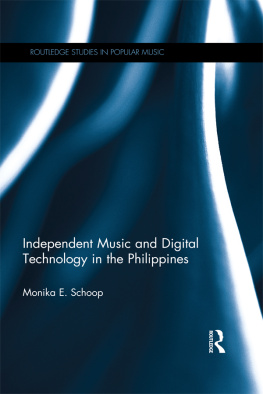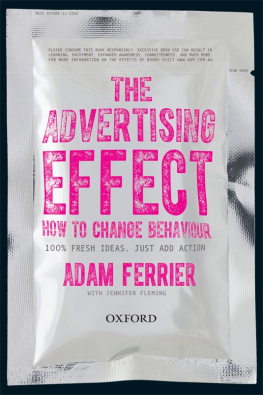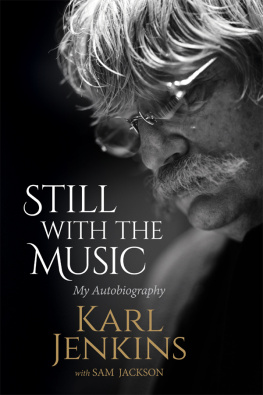
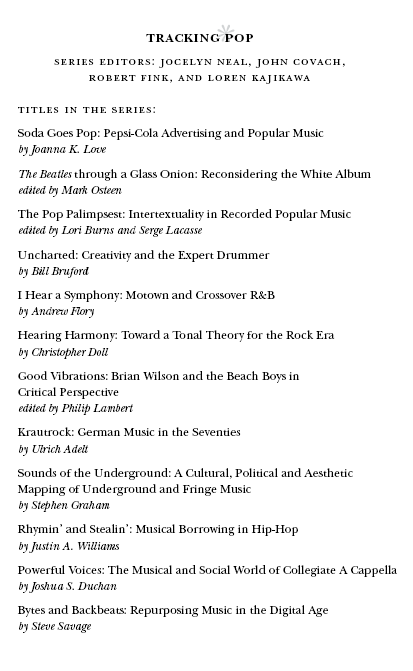
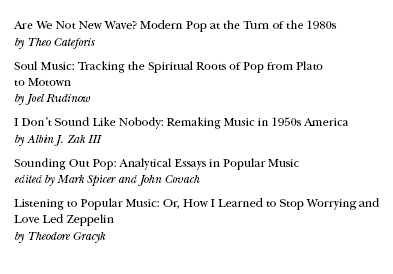
Soda Goes Pop
Soda Goes Pop
Pepsi-Cola Advertising and Popular Music
Joanna K. Love
University of Michigan Press
Ann Arbor
Copyright 2019 by Joanna K. Love
All rights reserved
This book may not be reproduced, in whole or in part, including illustrations, in any form (beyond that copying permitted by Sections 107 and 108 of the U.S. Copyright Law and except by reviewers for the public press), without written permission from the publisher.
Published in the United States of America by the
University of Michigan Press
Manufactured in the United States of America
A CIP catalog record for this book is available from the British Library.
Library of Congress Cataloging-in-Publication Data
Names: Love, Joanna K. author.
Title: Soda goes pop : Pepsi-Cola advertising and popular music / Joanna K. Love.
Description: Ann Arbor : University of Michigan Press, 2019. | Series: Tracking pop | Includes bibliographical references and index. |
Identifiers: LCCN 2019007780 (print) | LCCN 2019013242 (ebook) | ISBN 9780472124329 (E-book) | ISBN 9780472074020 (hardcover : alk. paper) | ISBN 9780472054022 (pbk. : alk. paper)
Subjects: LCSH: Music in advertisingUnited StatesHistory. | AdvertisingSoft drinksUnited StatesHistory. | Popular musicUnited StatesHistory and criticism. | PepsiCo, Inc.
Classification: LCC ML3917.U6 (ebook) | LCC ML3917.U6 L68 2019 (print) | DDC 781.5/9dc23
LC record available at https://lccn.loc.gov/2019007780
The University of Michigan Press gratefully acknowledges the support of the AMS 75 PAYS Endowment of the American Musicological Society, funded in part by the National Endowment for the Humanities and the Andrew W. Mellon Foundation, for the publication of this volume.
Cover image: Cola bottle iStock / Boarding1Now; Music notes iStock / RKaulitzki.
To my parents: John and Kathleen Love
Contents
Digital materials related to this title can be found on the Fulcrum platform via the following citable URL: https://doi.org/10.3998/mpub.9536286
Page viii Page ix
It takes a village to write a book, especially one that is almost a decade in the making. I would have to write another one as long as this to properly honor all of the wonderful mentors, colleagues, friends, and family members who have supported me along the way. Since the interest of space prevents such an endeavor, I name as many as possible here and hope that those, both named and unnamed, are aware of my deep and sincere appreciation.
I first thank my brilliant mentors at the University of California, Los Angeles, who helped me to cultivate many of the ideas present in this book. I am especially appreciative of Timothy D. Taylor, Mitchell Morris, and Douglas Kellner. I owe a very special note of thanks to Robert Fink, who guided me through each step of this process.
I express my sincere gratitude to my amazing colleagues who took the time to read and comment on individual chapters. I thank Marianna Ritchey, Alexandra Apolloni, Ross Fenimore, Jillian Rodgers, Samuel Baltimore, Lindsay Johnson, Sarah Gerk, and Danielle Sirek, as well as colleagues at the University of Richmond, including Rania Sweis, Mariela Mndez, Erika Damer, Julianne Guillard, and Eric Grollman. I extend my deepest gratitude to Danijela Kulezic-Wilson, who read the entire manuscript and offered insightful feedback to prepare it for review. I am also deeply appreciative of Karen Ahlquist and all those involved with the 2015 publication of the Journal for the Society of American Music article that would become portions of chapter 2.
I am further grateful for the opportunity to workshop various sections of this book at the first two Junior Faculty Symposiums sponsored by the Page x American Musicological Societys Popular Music Study Group. There were unfortunately too many attendees and mentors to name here, but I do want thank those who offered substantial feedback on early drafts, including Robynn Stilwell, Neil Lerner, Susan Fast, Brian Wright, Dan Blim, Kim Mack, and Katherine Reed. I especially thank the symposium coordinators, Eric Hung and Daniel Goldmark.
The University of Richmond has also provided me with invaluable resources for this project. I sincerely thank the Department of Music, and especially Jessie Fillerup, Andy McGraw, and Jeffrey Riehl for their support. I also acknowledge our wonderful music librarian and musicologist Linda Fairtile for helping to locate various materials. This project surely would not have been feasible without funding from the School of Arts & Sciences, Deans Office under the direction of Kathleen Skerrett and Patrice Rankine. I am further grateful for summer support allocated by the Faculty Research Committee.
I express my sincerest gratitude to the American Association of University Women, which made the completion of this book possible with a 201617 American Post-Doctoral Fellowship. I also thank those who provided access to essential archival materials, including Kay Peterson at the Archives Center of the National Museum of American History, Smithsonian Institution, and Martin Gostanian, who not only guided me through the materials available at the Paley Center for Media in Los Angeles but recommended excellent sources outside of the collection.
As always, I thank my strong network of family and friends. There are too many to name here, but I am forever indebted to John and Kathleen Love; Bill, Judy, and Kellen Evans; Christin Schillinger; and of course my rock and beloved, Mark Sanborn. Not least, I thank the University of Michigan Press and its exceptional faculty, staff, and reviewers. I am especially appreciative of Mary Francis who skillfully shepherded this book across the finish line along with Sarah Dougherty, Susan Cronin, and Kevin Rennells.
Page 1
Early Pop Jingles and Pepsis Shift to Youth Marketing
Page 2 Page 3
Hitting the Spot and Spotting the Hits
Forty-one years after a North Carolina pharmacist named Caleb D. Bradham compounded a fountain drink that would become known as Pepsi-Cola, Walter Mack was appointed the companys president and chief executive officer (CEO). The year was 1939, and the Phoenix Securities firm had been put in charge of mitigating the losses and lawsuits that plagued Pepsi and its parent company at the time, Loft Inc. Mack was cofounder and vice president of the securities company, but he would soon resign to devote his full attention to running the nascent soda brand.
The once failing company had finally begun to see gains due to its promise of 12-ounce bottles for only a nickela bargain that doubled Pepsis profits during the 1930s depression era. But even with its recent success Mack recognized that the brand needed a major image makeover to sustain its profitability. He knew the companys future rested on the ability of its consumers and franchised bottlers to invest in the company name, so he set out to streamline the look of its logo, as well as the products packaging. He also hired the Newell-Emmet advertising agency to create a nationwide marketing campaign that would solidify Pepsis value and win over potential consumers. The new campaign produced highly successful skywriting promotions, as well as a cartoon comic strip called
Next page

